Greetings to you all, and thanks for tuning in. This has been a rather chaotic week as I had no internet until Friday night, but if this is a shorter newsletter than usual fear not, it will be completed over the weekend ! And as I always say these are merely starting points with much more gen to be filled in as I discover it and as you add it.
Anyway this has been a fun newsletter with several cards which have never been featured before in our site. So I hope you enjoy it....
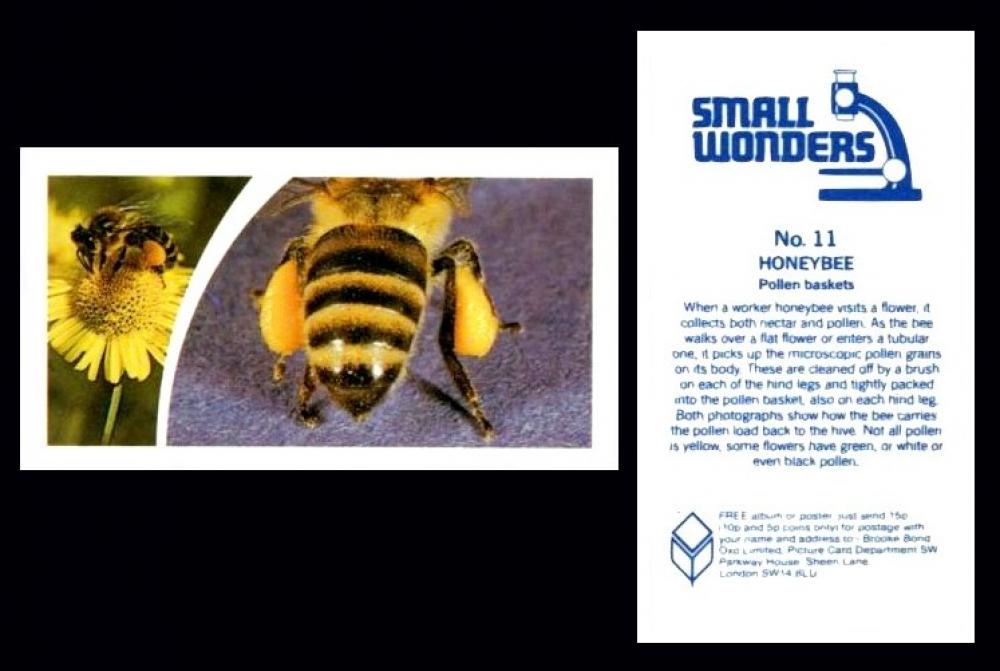
Brooke Bond "Small Wonders" (1981) card 11/40 - [trade : UK ; tea] BRM-60
Today it is honey bee day, and they need our help more than ever with climate change getting ever fiercer and faster. And its not too hard to help them, all we need to do is make sure that in our gardens and window boxes we add a few plants that they like to visit, and leave them a saucer of water so they can take a drink, and make sure that there are stones which are above and just below the surface of the water so that if they fall in they can climb out.
If you don`t have any garden, you can still help the bee by giving them a place to live, many stores sell little homes for bees and insects, or you can even make one.
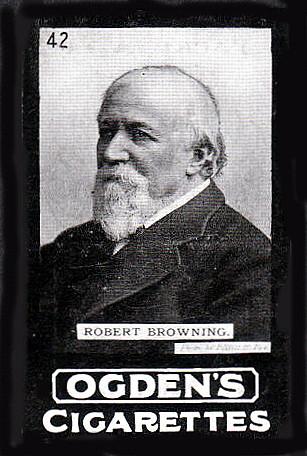
Today it is Poets Day and I`m not fond of this card so it might yet get replaced. Though I have to say I do like Robert Browning, and his secret love for his fellow poet, the fragile and secluded Elizabeth Barratt, who he most wonderfully rescued, and married, and swept off to Italy, and it all started with a simple letter. In all they exchanged almost six hundred letters over just under two years, and they wrote for almost six months before they even met.
How could you fail to be excited by that?
Unfortunately, and very sadly, although the union produced two children, she died young. I guess love does not always last, but it proves that we must grab at it and enjoy it whilst we are allowed.
He also gets my vote for being rather forward of his times, he was anti-slavery, pro-women`s rights, and a great animal lover, writing several poems to stand up for their rights and to show that they were to be our friends not our servants.
However I also admit that many of his poems are not always easy to understand or read, and you have to work at those a bit to decipher the often hidden meaning.
Despite this he does remain popular, with lines from his works often being quoted in popular movies and television shows, and many writers saying openly that they used his words to provide their inspiration.

Today in 1909 Cadillac changed its name to Cadillac Automobiles. And I`m glad it did as I have wanted to show one of these cards to you for some time and ask for assistance, for I have no idea of who issued them, how many there were, or what the set was called. It was obviously a carton issue as all my cards, and I have four, are cut rather awkwardly.
Any ideas please let me know...
Cadillac was actually founded through a bit of a disaster, when Henry Ford fell out with his key investors and they decided to send him into liquidation. To do this they needed someone impartial to value the fixtures and fittings and that man was Henry Leland, who came from a company that manufactured engines. Instead of doing what he was told, Leland convinced the investors to keep the items, and the factory, and let him fit his engines into the Ford cars, after sufficient modification.
Henry Leland, named the company La Mothe Cadillac after Antoine Laumet de la Mothe, sieur de Cadillac, who doesn`t sound to be my sort of person, he was a fur trader and not so kind to the Indians in his trading nor his treatment. However he did set up a trading post on what is now the city of Detroit, and the people who named the larger city that eventually turned up called it after him.
And I guess Mr. Leland must have had a big soft spot for him too, as not only were the cars called after him, but the crest of those cars was based on his coat of arms!
The first two models were finished and ready by October 1902, and though it was not really advertised, they were pretty much a Ford Model A in every way but the engine. However one of the many things Leland was great at was manufacturing, and from their first exhibition it was this that sold them, and the resulting reliability that made them popular with the public.
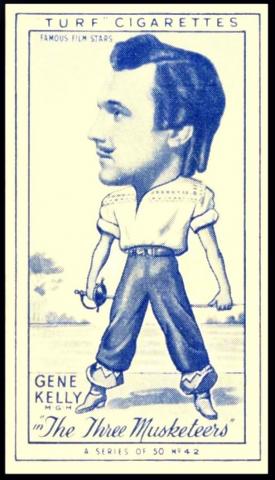
Carreras Turf branded "Famous Film Stars" (1949) card 42/50 - [tobacco : UK] C151-655 : C18-106
Today we celebrate Eugene Curran Kelly, born today in 1912, who was one of the many stars that are rather absent from cartophily, though I`m glad to say that he managed to scrape on to this Carreras Turf Slide showing "Famous Film Stars".
The problem, of course, was that Gene Kelly was a stage star through the 1930s, went to Hollywood in October 1941, and made his film debut in 1942, in "For Me and My Gal" with Judy Garland..... but most cigarette cards ended in 1939
Despite this he can be found on cards, and a whole set of twenty trading cards was issued in 2010 called "A Tribute To Gene Kelly", which includes stills from his most famous film "Singing In The Rain".
He continued to work in films until Xanadu, in 1980, which starred the sadly just passed Olivia Newton John. He was also involved with many of the great "That`s Entertainment" compilation films in the 1990s.
He died on February 2, 1996
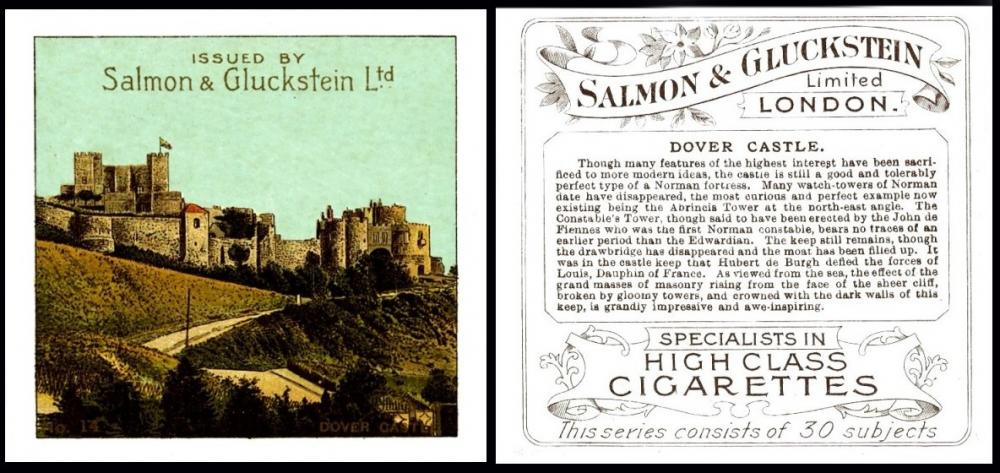
Salmon & Gluckstein "Castles, Abbeys & Houses" untitled, large size 76 x 73 m/m (1906) unnumbered/30 - [tobacco : UK] S041-090 : S16-3
You can find these cards with brown or red backs, the red back being the scarcer. In the 1950 London Cigarette Card Catalogue the brown were listed as 20/- to 60/- a card, whilst the red were 50/- to 150/-. No sets of either printing were in stock.
This may be an odd card, but stick with me, for today in 1875 Captain Matthew Webb slipped off the Admiralty Pier in Dover, with the castle in plain view, and swam to Calais in France. I am certain that he appears on a card, but have not found one, please do let us know if you spot one.
Matthew Webb was born on the 19th of January 1848, and had already had brushes with fame for his swimming, firstly when he dived overboard to rescue a man who had fallen off a liner into the Atlantic Ocean, and secondly by saving his younger brother from the Severn River.
The first rescue failed, and indeed the man`s body was never recovered, but for his efforts he was given £100 and a brand new gold medal, the Stanhope Medal, from the Royal Humane Society.
The second rescue was more personal, and luckily succeeded, but it also brought up the publicity of the first all over again.
His third famous swim saw him become the first person to cross the English Channel. He took just under twenty two hours. He found it tiring but was excited by the adulation of the crowds which followed him, asking what he would do next. He perhaps should have said that he was going to go home and plant a garden, but instead he embarked on ever more dangerous "stunts" which would eventually see him trying to swim the Whirlpool Rapids below Niagara Falls on the 24th of July 1883 .
Everyone said this was impossible, and sadly it proved to be so.
Matthew Webb died on the 24th of July 1883
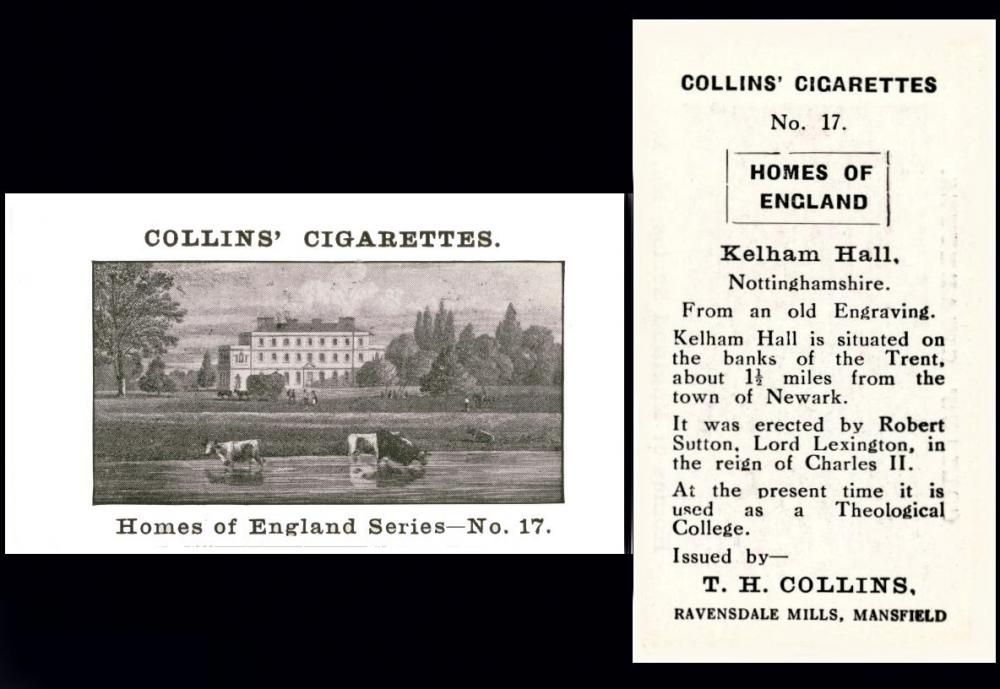
T.H. Collins "Homes of England" (1924) card 17/25 - [tobacco : UK] C669-400 : C106.1
Today we mark Nottinghamshire County Day, which has taken place only since 2021, one of the newest County Days.
We do this with a very unusual card, which we have not shown in a newsletter before - this card was issued by T.H. Collins, tobacco manufacturers of Ravensdale Mills in Mansfield, whose most popular brand was "Bow Bells". This card looks really ancient and I was quite surprised it was issued as recent as 1924. By the way there was a typesetting error at some stage and cards 18 and 25 have been seen with the bottom line saying "of England Homes".
These cards were issued in black and dark mauve - black is supposed to be very scarce, but I do wonder if they were not simply very dark mauve? They all show some degree of set off, which means they were piled up too soon after printing and the ink on the back and front merged together.
T. H. Collins also issued another set, in colour, the very popular "Sports and Pastimes - series 1", most recognisably issued by Taddy in 1912, though it was first issued by Redford six years earlier. We featured the Taddy version, and all the other issuers, in a previous newsletter, which you can read at https://csgb.co.uk/cardoftheday/2022-02-04
Kelham Hall is no longer a theological college. It is a Grade 1 listed building, but has seen many changes in its lifetime, not least its recent listing for sale as a future hotel and leisure complex. The hall gained fame during the English Civil War for being the temporary jail of King Charles I. It was destroyed twice. Sir George Gilbert Scott started refurbishing it in 1859 for a titled family, and they sold it in 1903 to the Society who made it into the Theological college, adding a chapel. It was occupied by troops in both World Wars, then returned to the peace and quiet of the college. That closed in the early 1970s and then it passed into the hands of the local council, who used it as their offices, until it was sold privately. It currently serves as a wedding venue.
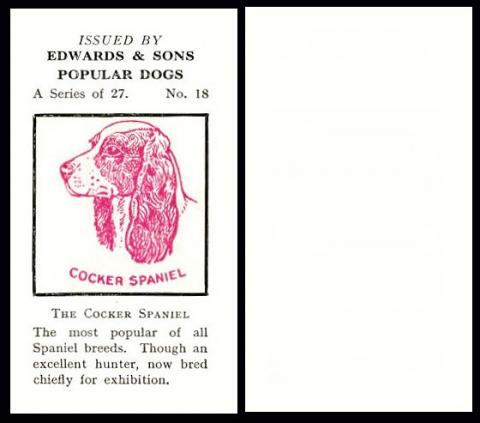
S. Edwards "Popular Dogs" (1954) card 18/27 - [trade : UK : confectionery, sweet cigarettes] EDW-120 : EDW-1
Today its International Dog Day in the USA but why not here?
This is another new set for us, Edwards & Sons "Popular Dogs" (1954) There is a huge amount of work in this card, the darker parts of the dog`s head being made up of many lines, which you really only notice on close inspection.
Edwards issued other sets too, 12 "Products of the World" (1953), 25 "Transport of the World" issued first (1955) with non descriptive backs, then with descriptions added the following year, and 25 "Wonders of the Universe" (also 1956)
Edwards & Sons were confectioners in South East London, close to Crystal Palace, and their brands included "Lucky Dip" Sweet Cigarettes, which issued the set of twenty-five "Transport - Present and Future", as well as "Wonders of the Universe". There was also the unbranded set of twelve "Products of the World" (1957)
This week's Cards of the Day...
see us coming down from last week`s heart stopping trip up to the top of the mountains and looking into the soul of the feet as it was "National I Love My Feet Day" on the 17th of August.
Saturday, 13th August 2022
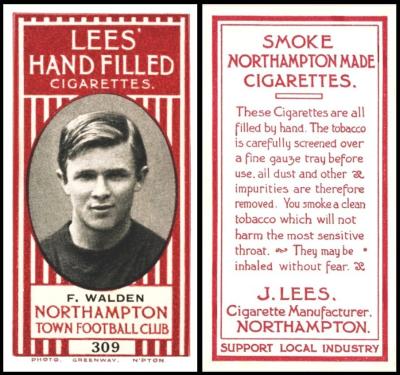
The clue here was not the team, Northampton Town, which was fairly easy to spot - instead it was their nickname, the Cobblers, which is the correct name for a shoemaker, and hopefully a good one who make shoes that fit our feet like gloves.
The connection between the shoe and Northampton is a long one, for it was already known as a centre of shoe and boot making in the seventeenth century. However it was the Industrial revolution that added the power in every way. Originally boots and shoes were made by home workers, paid by the piece - but once mechanisation came along it was much faster and cheaper to have them made in a factory setting. This also changed the landscape, for it was this industry which first came up with the idea of housing their workers in rows, all leading to the factory.
Northampton Town started off at the County Ground, in 1897, and they stayed there right until 1994, when they moved to their present ground - which is called Sixfields. You can read their full story at their own Club Website
Our player, Frederick Ingram "Fanny" Walden, he was born on March 1, 1888 in Wellingborough, Northamptonshire. He was known as "The Cobblers Midget", but was not so small really, 5 ft 2 ins. However he was an amazing player, able to weave his way through all defences, so good that he was bought by Tottenham Hotspur in 1912, for the amazing price of £1,700, and he stayed there until 1926. He also played football internationally, for England, twice, and cricket, for Northamptonshire.
And he appears on at least three cigarette cards :
W.D. & H.O. Wills "Famous Footballers" Scissors Brand (1914) 31/50 -
as F. Walden (Tottenham). This text is quite intriguing as it says that the nickname "...was designated by his admirers at Northampton, by reason of his resemblance to a little girl...". It adds that "He only stands 5 ft.2 1/2 ins., and weighs 9 stone 3 lbs." As for his sporting prowess this card adds more, saying he "...is a good swimmer, and a boxer of no mean ability " There are also anomalies, for it calls him "Fred Walden", the only card so far to do so, and it says he was born at "Wellington" not Wellingborough.
W.A. & A.C. Churchman "Footballers (1914) 15/50 -
as F. Walden - this shows him at Tottenham Hotspur but tells us he "played for Kettering before joining Northampton". The text also says "Although on the small side, "Happy Fanny", as he is generally known, has been the undoing of many strong defences".
F. & J. Smith "Football Club Records 1916-17’ (1918) –
as F. Walden, O.H.M.S. (Tottenham Hotspur) - the O.H.M.S. standing for On His Majesty`s Service, or in other words fighting in the First World War. And you can read a bit about this at FootballWW1/Walden
He also appears in the text on the reverse of Ogden`s and Hignett`s "A.F.C. NICKNAMES" where it closes rather oddly, with : "In those days they had several fine players, the most famous being Walden, the midget outside right".
Our Directory of British Issuers (RB.7, published in 1946) tells us that J. Lees were at Bridge Street, Northampton, and that they were a wholesale tobacconist and stationer. Intriguingly it then says they “sponsored one set of local interest, “Northampton Footballers” (1915).” Sponsored is an odd term, but they seem not to have had a brand, these cards just saying “Northampton Made Cigarettes”, and perhaps this was a combination effort between local growers, one of whom suggested issuing cards, which Lees agreed to pay for the production thereof.“ After all, at the bottom of the reverse it says, proudly, “Support Local Industry”, and the first line of text, “These Cigarettes are all filled by hand”, suggests local workers too. Our original World Tobacco Issues Index does try to ruin my idyllic, co-operative dream, by saying Lees were a “Cigarette Manufacturer” - but this is on the card, and it actually means they were the maker, at the root of the tree, and there maybe there was no space to list the branches.
It also tells us the cards were issued 1915, and catalogues them as :
NORTHAMPTON TOWN FOOTBALL CLUB. Sm. 67 x 35. Portrait in oval in black and white, surround in maroon. No`s 301/321 seen (?21).
This wording is repeated exactly in our updated World Tobacco Issues Index. However we do now know that the first “3” was a prefix, though not why, and that there are indeed twenty-one cards in the set.
Before we leave the card, look right down the bottom on the front and you will see a small line of type, “PHOTO GREENWAY, N`PTON”. This is Samuel H. Greenway, one of the largest of the area`s photographers, with studios at Northampton and Daventry. They also made photo postcards, and offered "outdoor photography" from the early 1900s.
Sunday, 14th August 2022
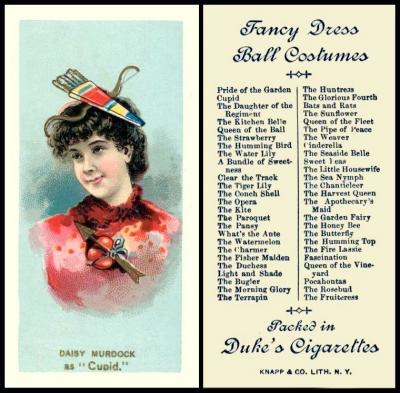
which gave us Cupid, the love element of loving your feet. And the earliest card of the week.
You may think that a set of "Fancy Dress Ball Costumes" would be boring, but the subjects are rather fun and much amusement may be gained from working out what the costume means, certainly a lot of thought has gone into them.
They also feature leading stage stars and beauties of the day and here we have Daisy Murdoch, very popular at the time, and what she was most known for was for playing Cupid. This was in a production of Orpheus and Euridice, staged by the Bijou Opera Company, and it travelled America in the mid 1880s. You can read more about her online at The Metropolitan Museum site where it also details how her image was used by other tobacco manufacturers.
Our cards, on which her name was spelt wrong, it was definitely MurdocH, not MurdocK, were lithographed by Knapp & Company of New York, and, to give cartophilists an extra thrill, a set was owned by Jefferson Burdick, who said it was one of his favourites.
Sadly he did not select a single card, so we must guess which one he liked best, without ever knowing if we were right....
Monday, 15th August 2022
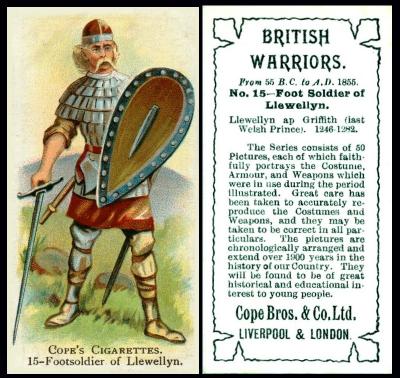
Here we have the foot, a foot soldier, so named because they walked and marched on their own feet, rather than being mounted on a horse.
The card tells us this is a foot soldier of Llewellyn ap Griffith, the first Welsh Prince, but of course this has been anglicised by Cope as he would have been known as Llywelyn ap Gruffydd.
He was also known as Llywelyn the Last, for he was the last native Prince of Wales, a title he held from 1258 until his death in 1282
By the way the a in the code stands for a variation, because these cards can be found with the text on the backs in a) black or b) grey.
And the really strange thing about the text is that every card is identical, only the top title changes
Tuesday, 16th August 2022
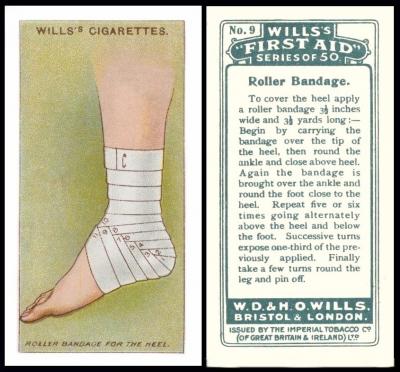
And a rather shapely foot we have here, quite unlike the other foot card in Wills` "First Aid", which is sporting a triangular bandage, and looks like someone has simply covered it in a duvet , gathered it together, and put an elastic band round the top!
The bandage here also looks very elegant, but I am certain that it was only ever done to this exactness in a quiet hospital, carefully following the numbers which are so helpfully drawn in. It is definitely not a bandage to be done on a hectic battleground, where men are coming in at regular intervals and there is simply not the time to waste to do this sort of thing.
Oddly, the numbers are not mentioned at all on the text, which does suggest the original drawing might have come from some kind of manual or chart, so I will try and track that down.
I have found out that in July 1913 the Field Service Manual for the Army Medical Service was reprinted and updated but I have not found any that I can have a look inside.
There are two versions of this card, which is noted in our original reference book to the issues of W.D. & H.O. Wills. Both are now in our gallery, so click the bold link below to compare them. The text in this reference book reads :
61. FIRST AID. Fronts lithographed in colour; backs in grey, with descriptive text. Home issues :-
A. Without Album Clause. Issued, 1913
B. With Album Clause. Issued, 1915.
The Album Clause means the wording which appears down both sides of the reverse text, and on our card it is missing.
We also know the months of issue, April 1913 for "without" and January 1915 for the "with". That seems to be at odds with our World Tobacco Issues Indexes though, as both the original and the updated version gives the "A" suffix to the cards with the album clause and the “B” to the cards without.
Wednesday, 17th August 2022
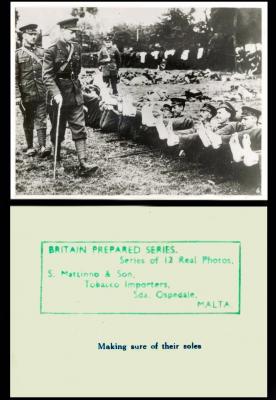
A very unusual set which we dealt with in a previous newsletter. I will add the link over the weekend. This mention failed to bring forth any new information, but it only appears in our original World Tobacco Issues Index as after that date it was decided not to have been issued with Tobacco at all.
The cards fall into three groups, twelve cards each of the Army, the Navy and the Air Force.
The last time it was mentioned I was under the impression that it might have been sold to raise funds for a hospital, for "Ospedale", which appears on the cards, means hospital in Maltese.
However I am coming to think they might have been propaganda. Look at this card closely, and wonder why the soldiers are showing their feet to the officers? It might say that they are being inspected, but nobody is looking as they march past. Was this a clever ploy to say our ranks are unruly? That our men show their feet as a mark of disrespect - as it is in many Eastern Countries, these being the parts that touch the ground and should never be seen? Very intriguing...
Thursday, 18th August 2022
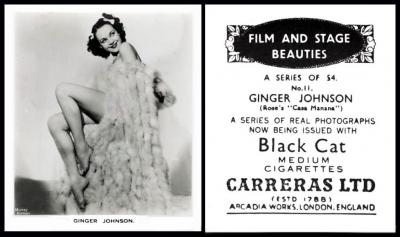
Very confusing, and one that might need more investigation. I have been unable to find this Ginger Johnson, though her name is currently used by a Drag Artist. This means the original is probably not using her name any more but also was not famous enough to register it so that it could not be used until seventy years after her death.
I said I had not yet tracked down the club, but now I have, Rose`s Casa Manana was a revue show and the Rose was actually Billy Rose, who was a theatrical impresario and was married to Fanny Brice. It was filmed in 1938, but I cant find our girl, so more researching!
This set was issued in several formats - firstly as a series of 54 cards in either a standard size (issued January 1939) or our medium version (March 1939) - and secondly as a series of 36 cards in large size (February 1939) or extra large (November 1939).
I am not sure how the subjects were selected, and why. Our Ginger Johnson has rather good feet, and is posed very artistically, but did she only serve as a glimpse of glamour that fuelled a few fantasies and was then forgotten? Or was her hope that her spot of posing would lead to a spot in a movie, from where fame would surely come?
Alas, she must have been disappointed.
Friday, 19th August 2022
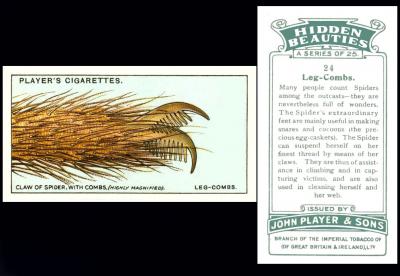
Just to prove feet come in all shapes and sizes, and degrees of hairiness, here are the feet of an arachnid.
In our original John Player reference book RB.17, they are described as "Small cards. A natural history series. Fronts in colour. Backs in grey with descriptive text. Home issue, July 1929"
This is one of a pair of sets, the other being "Struggles for Existence", which are very under-valued and truly fascinating, for they are the seldom seen subjects of the natural world, magnified, something that a scientist gets to see and work with every day but the general public would probably never get to see.
They are also descendants of the early lantern slides, which often featured small things expanded.
The truth is that like these cards much insect and animal life is also under-valued, but once you are allowed to really see how its parts function, and how beautiful it can be, hopefully you gain new respect for it.
Made it, at 00.43, not bad at all.
I am just off to take the dog in the garden, he is most put out by the fact we stopped sleeping out there, something we resorted to during that spell of hot weather!
I enjoyed doing that as well.
After we come in (and that may be quite a while) I will start typing something else!
